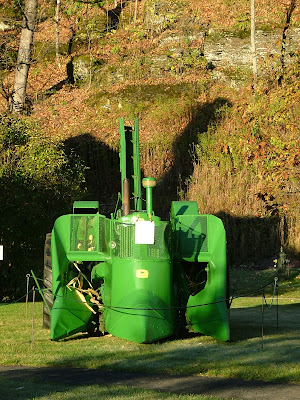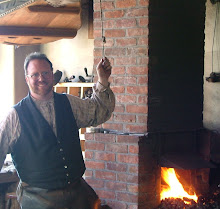The Farmers' Museum reopens to the public on Saturday, December 11th for
Candlelight Evening. Since we are preparing to celebrate the season in 19th century style, I thought it would be appropriate to revisit the poem that helped to define Christmas as an American secular holiday.
Clemet Clark Moore was a scholar, a published author of literary translation, and a poet. He seems to have been a serious and scholarly man of wealth, privilege, and influence. It is intriguing that this man of gravitas and serious mein is attributed the poem that helped solidify and define the American Christmas tradition of the 19th century.
A Visit from St. Nicholas
'Twas the night before Christmas, when all thro' the house
Not a creature was stirring, not even a mouse;
The stockings were hung by the chimney with care,
In hopes that St. Nicholas soon would be there;
The children were nestled all snug in their beds,
While visions of sugar plums danc'd in their heads,
And Mama in her 'kerchief, and I in my cap,
Had just settled our brains for a long winter's nap —
When out on the lawn there arose such a clatter,
I sprang from the bed to see what was the matter.
Away to the window I flew like a flash,
Tore open the shutters, and threw up the sash.
The moon on the breast of the new fallen snow,
Gave the lustre of mid-day to objects below;
When, what to my wondering eyes should appear,
But a miniature sleigh, and eight tiny rein-deer,
With a little old driver, so lively and quick,
I knew in a moment it must be St. Nick.
More rapid than eagles his coursers they came,
And he whistled, and shouted, and call'd them by name:
"Now! Dasher, now! Dancer, now! Prancer and Vixen,
"On! Comet, on! Cupid, on! Donder and Blitzen;
"To the top of the porch! To the top of the wall!
"Now dash away! Dash away! Dash away all!"
As dry leaves before the wild hurricane fly,
When they meet with an obstacle, mount to the sky;
So up to the house-top the coursers they flew,
With the sleigh full of toys — and St. Nicholas too:
And then in a twinkling, I heard on the roof
The prancing and pawing of each little hoof.
As I drew in my head, and was turning around,
Down the chimney St. Nicholas came with a bound:
He was dress'd all in fur, from his head to his foot,
And his clothes were all tarnish'd with ashes and soot;
A bundle of toys was flung on his back,
And he look'd like a peddler just opening his pack:
His eyes — how they twinkled! His dimples: how merry,
His cheeks were like roses, his nose like a cherry;
His droll little mouth was drawn up like a bow,
And the beard of his chin was as white as the snow;
The stump of a pipe he held tight in his teeth,
And the smoke it encircled his head like a wreath.
He had a broad face, and a little round belly
That shook when he laugh'd, like a bowl full of jelly:
He was chubby and plump, a right jolly old elf,
And I laugh'd when I saw him in spite of myself;
A wink of his eye and a twist of his head
Soon gave me to know I had nothing to dread.
He spoke not a word, but went straight to his work,
And fill'd all the stockings; then turn'd with a jerk,
And laying his finger aside of his nose
And giving a nod, up the chimney he rose.
He sprung to his sleigh, to his team gave a whistle,
And away they all flew, like the down of a thistle:
But I heard him exclaim, ere he drove out of sight
Happy Christmas to all, and to all a good night.
—Clement Clark Moore
The poem was first published in 1823 in The Sentinel newspaper of Troy, NY, and was immensely popular by 1845. There was even debate over whether Moore was really the author. That stems in part from the initial publishing being done anonymously. Moore included the poem in an anthology of his work published in 1844.
The light and cheerful poem is quite different from his more scholarly and serious writing. He noted that it was written for his children, and only published at their insistence. Not only does this poem provide a glimpse into the development of American conceptions of Christmas as a secular holiday, but also an unexpected glimpse into the home life of a scholarly and private 19th century gentleman.
Warm holiday wishes from all of us at The Farmers' Museum.



















































